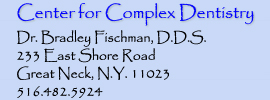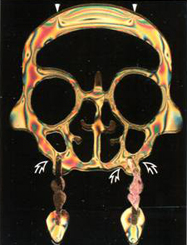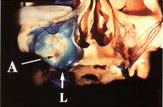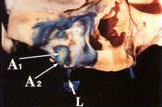 |
 |
In their articles “Stress Distribution around maxillary implants in anatomic photoelastic models of varying geometry Part I and Part II” (J Prosthet Dent 2001;85 442-9; and 450-4), Drs. Martin Gross and Joseph Nissan present a new way of viewing photoelastic studies, and some interesting findings. Molding photoelastic material according to a CAT Scan of an individual with implants in place, they then placed the implants under varying degrees of stress in centric relation. The major area of stress was at the cortical plate at the concavities near the apex, not at the apex, as has been shown in block studies.
The arrows at the right demonstrate high stress at the buccal concavity near the apex of a straight implant on the ‘patient’s’ right. On the patient’s left a 25 degree angulation resulted in high stress on both the buccal concavity and the palatal concavities. These locations of stress were constant through the experimentation with angulation and greater force increasing the visibility of the palatal stress.
Lateral stress, created by movement of the mandible, resulted in the buccal and labial concavities as well as the area buccal to the neck of the implant exhibiting stress. The concavity stress in vertical as well as lateral force pictures was not next to the implant, but at the cortical plate. To confirm this finding, another format of photoelastic study was accomplished.
They placed a photoelastic coating over the buccal plate of a skull, and cemented an implant into an equivalent site. Vertical and lateral forces on the implant created the same stress pattern. Remember, the photoelastic material was labial to the buccal plate.
The clinical significance of these articles rests in a reevaluation of our concept of stress transmission in maxillary implant situations. If much of the vertical as well as lateral stress is exhibited on the buccal plate of the maxillary alveolus, then the necessary thickness of this bone may have to be greater than the biological width of 1mm to support the stress. This is particularly true at the buccal concavity, an area we have always considered unimportant in implant survival and have routinely perforated surgically.
 |
 |
 |
 |
Dentures | Extreme Makeovers | Doctor's Credentials | Map & Policies | Contact Us
Home | Professional Referrals | Tidbits for Dentists | Newsletters for MDs